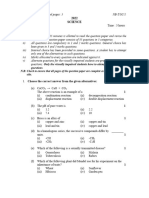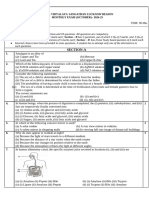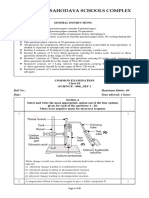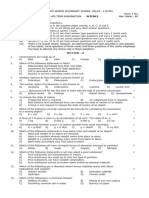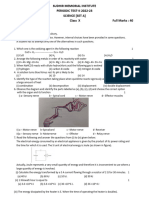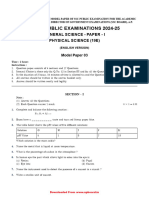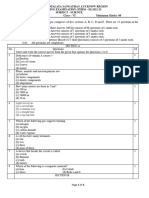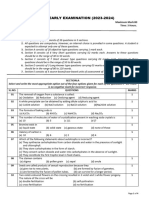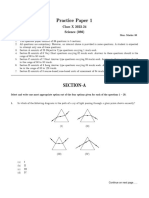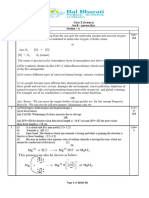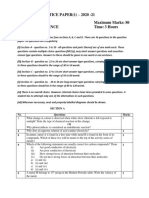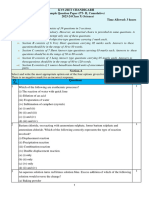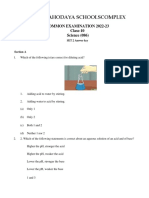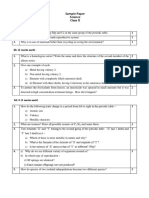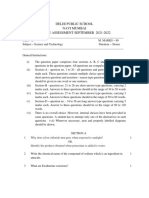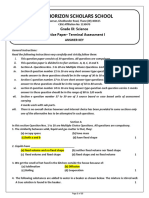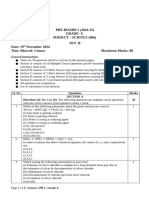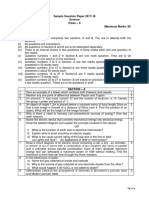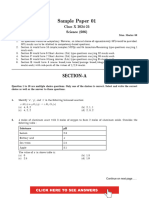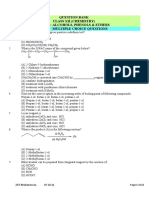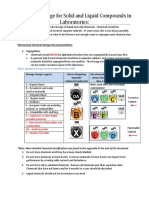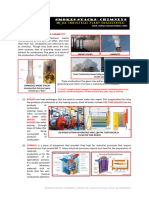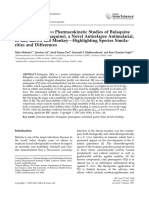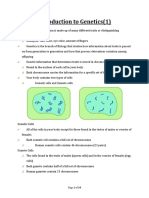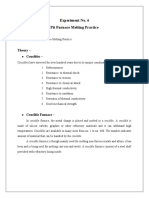QN Banks
QN Banks
Uploaded by
krishnendu.adak9876Copyright:
Available Formats
QN Banks
QN Banks
Uploaded by
krishnendu.adak9876Original Title
Copyright
Available Formats
Share this document
Did you find this document useful?
Is this content inappropriate?
Copyright:
Available Formats
QN Banks
QN Banks
Uploaded by
krishnendu.adak9876Copyright:
Available Formats
Total number of printed pages: 5 NB-T/SC/1
2021
SCIENCE
Total marks : 80 Time : 3 hours
General instructions:
i) Approximately 15 minutes is allotted to read the question paper and revise the
answers. The question paper consists of 26 questions in 5 categories.
ii) All questions are compulsory.
iii) Internal choice has been provided in some questions.
iv) Marks allocated to every question are indicated against it.
v) Alternate questions for the visually impaired students are provided in some
questions. Only the visually impaired students has to attempt such alternate
questions.
N.B: Check that all pages of the question paper is complete as indicated on the top left side.
1. Choose the correct answer from the given alternatives:
(a) The decomposition of vegetable matter into compost is an example of 1
(i) endothermic reaction (ii) decomposition reaction
(iii) exothermic reaction (iv) combination reaction
(b) Which among the following is the most reactive metal? 1
(i) Magnesium (ii) Calcium
(iii) Zinc (iv) Aluminium
(c) Ethane with the molecular formula C2H6 has 1
(i) 6 covalent bonds (ii) 7 covalent bonds
(iii) 8 covalent bonds (iv) 9 covalent bonds
(d) The atomic number of an element is a more fundamental property than its
atomic mass was showed by 1
(i) Henry Mosely (ii) J. Dobereiner
(iii) John Newland (iv) Mendeleev
(e) The hormone that regulates blood sugar level is 1
(i) thyroxine (ii) testosterone
(iii) insulin (iv) oestrogen
(f) Characters transmitted from parents to offspring are present in 1
(i) cytoplasm (ii) ribosomes
(iii) golgi bodies (iv) genes
(g) A virtual and erect image can be obtained by using a concave mirror if
an object is placed 1
(i) between P and F (ii) at infinity
(iii) between C and F (iv) at C
-2- NB-T/SC/1
(h) The least distance of distinct vision for a young adult with normal
vision is 1
(i) 25m (ii) 2.5m
(iii) 25cm (iv) 2.5cm
(i) What do this symbol represent in a circuit diagram? 1
(i) An open switch (ii) A closed switch
(iii) A battery (iv) A wire joint
(j) The nature of magnetic line passing through the center of a current
carrying circular loop would appear as 1
(i) circular (ii) eclipse
(iii) parabolic (iv) straight line
Answer the following questions in one word or one sentence:
2. Name any two natural acid-base indicators. 1
3. What is anodizing? 1
4. Write two allotropes of carbon. 1
5. What will be the ratio of F2 progeny, if F1 tall plants reproduce by
self-pollination? 1
6. Name any two devices in which electric motors are used. 1
Answer the following questions in about 20-30 words:
7. Balance the following chemical equations:
(i) NaOH + H2SO4 → Na2SO4 + H2O
(ii) Pb(NO3) → PbO + NO2 + O2 1+1=2
Alternate question for the visually impaired students:
What is a balanced chemical equation? Why chemical equation needs to be
balanced? (1+1=2)
8. Why does menstruation occur? 2
9. A person has difficulty reading newspaper. What could be the defect the person
has? How can it be corrected? 1+1=2
10. State Ohm’s Law. Express it mathematically. 1+1=2
11. State Fleming’s Left Hand Rule. 2
Answer the following questions in about 40-60 words:
12. What is a redox reaction? Give any two examples. 1+2=3
-3- NB-T/SC/1
13. a. Write any three uses of washing soda.
Or 3
b. Write any three uses of bleaching powder.
14. Write any three differences between metals and non-metals basing on their
physical properties. 3
15. Explain the cleansing action of soap and draw the formation of a micelle.
2+1=3
Alternate question for the visually impaired students:
Differentiate between soaps and detergents. What causes hardness of water?
(2+1=3)
16. State the three events that occur during the process of photosynthesis. 3
17. Why is it important for us to have iodised salt in our diet? Iodine is necessary
for the synthesis of which hormone in the human body? Write one symptom
caused due to lack of iodine in the diet. 1+1+1=3
18. Explain the sex determination in human beings. 3
19. a. An object 5cm in length is placed at a distance of 20cm in front of a convex
mirror of radius of curvature 30cm. Find the position of the image, its nature
and size.
Or 3
b. A 2cm tall object is placed perpendicular to the principal axis of a convex lens
of focal length 10cm. The distance of the object from the lens is 15cm. Find the
nature, position and size of the image. Also, find its magnification.
Alternate question for the visually impaired students:
Define: (i) Pole
(ii) Radius of curvature
(iii) Principle axis of spherical mirrors. (3×1=3)
20. a. What is a spectrum? Explain in brief how rainbow is formed.
Or 1+2=3
b. What is Tyndall effect? Explain in brief why the colour of the sky appears blue.
-4- NB-T/SC/1
21. a. An electric lamp, whose resistance is 20Ω and a conductor of 4Ω resistance are
connected to a 6V battery in the given figure.
Calculate:
(i) the total resistance of the circuit
(ii) the current through the circuit
(iii) the potential difference across the electric lamp and conductor.
Or 3
b. An electric bulb is connected to 220V mains. The current is 0.50A. What is the
power of the bulb? If the bulb operates for 8 hours per day, what will be the
cost of the energy to operate it for 30 days at 300 per kWh?
Alternate question for the visually impaired students:
Write three applications of heating effect of electric current. (3×1=3)
Answer the following questions in about 70-100 words:
22. On what basis did Mendeleev arrange the elements in his periodic table. State
Mendeleev’s periodic law. Write three limitations of Mendeleev’s periodic
table. 1+1+3=5
23. a. Describe the structure of the human heart with a labelled diagram.
Or 3+2=5
b. Explain the mechanism for exchange of gases in human lungs, with a labelled
diagram of the human respiratory system.
Alternate question for the visually impaired students:
(i) What is the function of carbohydrates in plants? How is it stored, if it is not
used immediately?
(ii) In what form is food stored in our body?
(iii) What is the green pigment found in chloroplasts?
(iv) Name a plant that takes CO2 at night and act on it during the day.
(2+1+1+1=5)
-5- NB-T/SC/1
24. a. Name any two sexually transmitted diseases. Explain four different methods of
contraception. 1+4=5
Or
b. Explain asexual reproduction by fission and vegetative propagation with one
example each. 2½+2½=5
25. a. Draw a ray diagram to show the image formation by a concave mirror, when an
object is placed between C and F. Write any three uses of concave mirror.
Or 2+3=5
b. Draw a ray diagram to show the image formation by a convex mirror, when an
object is placed between infinity and the pole P of the mirror. Write any three
uses of convex mirror.
Alternate question for the visually impaired students:
List any three uses of concave mirror and any two uses of convex mirror.
(3+2=5)
26. a. Explain the working of an electric motor with a labelled diagram.
Or 3+2=5
b. Explain the working of an electric generator with a labelled diagram.
Alternate question for the visually impaired students:
What is an electric motor and an electric generator? Give the principle of the
working of an electric motor and a generator. Write the full forms of AC and
DC. (2+2+1=5)
*******************************
You might also like
- Isucceed Sample Paper 16 Science 10Document6 pagesIsucceed Sample Paper 16 Science 10Shivam Champion67% (3)
- Chennai Sahodaya Science Set 2 QP 2022-23 FOR PRACTICE ONLYDocument10 pagesChennai Sahodaya Science Set 2 QP 2022-23 FOR PRACTICE ONLYvro hamza80% (10)
- QN BanksDocument5 pagesQN Bankskrishnendu.adak9876No ratings yet
- Practice Paper X Science PT 2 Cumulative 2023-24-1Document11 pagesPractice Paper X Science PT 2 Cumulative 2023-24-1saumya judeNo ratings yet
- General Instructions:: 2020 Science (Oc)Document4 pagesGeneral Instructions:: 2020 Science (Oc)jaadarsh14No ratings yet
- X ScienceDocument4 pagesX Science7C HARSHAD KNo ratings yet
- 21bc02e1-96be-494f-bc00-546231309b41Document5 pages21bc02e1-96be-494f-bc00-546231309b41Baljeet SinghNo ratings yet
- Science Physics Pre-BoardDocument10 pagesScience Physics Pre-BoardAnnesha MondalNo ratings yet
- CSSC - Qp-Science-10-Cssc-Set 1Document8 pagesCSSC - Qp-Science-10-Cssc-Set 1Mathan100% (2)
- 2.SCIENCE-QPDocument9 pages2.SCIENCE-QPAayan ANo ratings yet
- IX Practice-Paper Science 18-19Document4 pagesIX Practice-Paper Science 18-19poonamsri1974No ratings yet
- X QP Science 23-24.set ADocument7 pagesX QP Science 23-24.set Awatchtimea5No ratings yet
- X QP Science 23-24.set BDocument8 pagesX QP Science 23-24.set Bwatchtimea5No ratings yet
- JSC Science SQP-1 2023-24Document6 pagesJSC Science SQP-1 2023-24Jayant ChowdhuryNo ratings yet
- Science QP Set 1Document6 pagesScience QP Set 1Aditi PandyaNo ratings yet
- Science MTDocument4 pagesScience MTUtkarsh ChoudharyNo ratings yet
- Science 10aDocument2 pagesScience 10aSumana MandalNo ratings yet
- 516271126-SSC GS Physical Science Model Paper-3 2024-2025Document3 pages516271126-SSC GS Physical Science Model Paper-3 2024-2025sanvrijangraNo ratings yet
- 1 Model Question PaperDocument10 pages1 Model Question PaperGeethika SriNo ratings yet
- VI Science QPDocument4 pagesVI Science QPDeepak MeenaNo ratings yet
- QP X ScienceDocument4 pagesQP X Sciencesaudaminidei76No ratings yet
- CSSC - QP Science 10 CSSC Set21705552004Document8 pagesCSSC - QP Science 10 CSSC Set21705552004MeenakshiSundareshNo ratings yet
- 931 Science EDocument5 pages931 Science Esc23156161No ratings yet
- Science 1Document9 pagesScience 1Alok GiriNo ratings yet
- science paperDocument8 pagesscience paperjosephalt1999No ratings yet
- Grade X-SCIENCE-MIDTERM-SAMPLE PAPERDocument8 pagesGrade X-SCIENCE-MIDTERM-SAMPLE PAPERZEONo ratings yet
- Set-I Kendriya Vidyalaya Sangathan Bhopal Region Pre Broad 2020Document10 pagesSet-I Kendriya Vidyalaya Sangathan Bhopal Region Pre Broad 2020Vikram SinghNo ratings yet
- Isucceed Sample Paper 18 Science 10Document5 pagesIsucceed Sample Paper 18 Science 10Mamta KhandelwalNo ratings yet
- X MS Science 23-24.set BDocument7 pagesX MS Science 23-24.set Bwatchtimea5No ratings yet
- QP 10 Sci PreBoard-2 Set-BDocument9 pagesQP 10 Sci PreBoard-2 Set-BlakshitshilpinishantNo ratings yet
- Practice Paper - 3 Subject: Science Grade: 10 Max. Marks: 80 Date: 21-12-2020 Time: 3 HrsDocument7 pagesPractice Paper - 3 Subject: Science Grade: 10 Max. Marks: 80 Date: 21-12-2020 Time: 3 HrsSankalp PariharNo ratings yet
- Section-A: Time Allowed: 3 Hours Maximum Marks: 80 General InstructionDocument3 pagesSection-A: Time Allowed: 3 Hours Maximum Marks: 80 General InstructionHarshit ChoukseyNo ratings yet
- SCIENCE Revision Paper - 1 19-12-2020Document7 pagesSCIENCE Revision Paper - 1 19-12-2020Sankalp PariharNo ratings yet
- CSSC - QP Science 10 CSSC Set 31705552005Document8 pagesCSSC - QP Science 10 CSSC Set 31705552005MeenakshiSundareshNo ratings yet
- Practice Paper X Science PT 2 Cumulative 2023-24 4Document8 pagesPractice Paper X Science PT 2 Cumulative 2023-24 4pranitmishra42No ratings yet
- Adobe Scan Jul 21, 2022Document2 pagesAdobe Scan Jul 21, 2022ashutosh kumar jenaNo ratings yet
- GISPreboardDocument6 pagesGISPreboardHarshaNo ratings yet
- Practice Paper Ix Science PT 2 Cumulative 2023-24Document8 pagesPractice Paper Ix Science PT 2 Cumulative 2023-24Ojaswi GoelNo ratings yet
- Set-1 See Class Ix Science Q.P.Document7 pagesSet-1 See Class Ix Science Q.P.yashrathod1986No ratings yet
- Chennai Sahodaya Science Set2 Answer Key 2022-23 PDFDocument17 pagesChennai Sahodaya Science Set2 Answer Key 2022-23 PDFsethu ks67% (3)
- Important Question Class 10 Jan 2024Document5 pagesImportant Question Class 10 Jan 2024shaikh nagmaNo ratings yet
- Class 10 Science Set 1 (31!1!1) 2024 Question Paper With SolutionsDocument30 pagesClass 10 Science Set 1 (31!1!1) 2024 Question Paper With Solutionsspinachgunda69No ratings yet
- Sample Paper Science Class X: VSA: (1 Marks Each)Document6 pagesSample Paper Science Class X: VSA: (1 Marks Each)VinithNo ratings yet
- prelim 1 newDocument6 pagesprelim 1 newjadejabheemdevsinhNo ratings yet
- Delhi Public School Navi Mumbai Online Assessment September 2021-2022Document10 pagesDelhi Public School Navi Mumbai Online Assessment September 2021-2022Aryaman MalhotraNo ratings yet
- smitha_m_1_678421Document10 pagessmitha_m_1_678421kmokshita4No ratings yet
- CBSE Class IX Science Sample Paper - Class Work Time: 3 Hrs Total Marks: 80Document7 pagesCBSE Class IX Science Sample Paper - Class Work Time: 3 Hrs Total Marks: 80Nasiruddin MirzaNo ratings yet
- X Cbse Science Sample Paper 3Document11 pagesX Cbse Science Sample Paper 3ashribad3496No ratings yet
- Grade 9-Term 1-Practice Paper - Answer Key - 2024-25Document13 pagesGrade 9-Term 1-Practice Paper - Answer Key - 2024-25dhageravi271No ratings yet
- DOC-20241123-WA0068Document8 pagesDOC-20241123-WA0068vaibhave BhatiaNo ratings yet
- CLASS X SCIENCE (SP-08) 19-10-202begnegnegney4Document7 pagesCLASS X SCIENCE (SP-08) 19-10-202begnegnegney4pragunagarwalxNo ratings yet
- Science SQPDocument4 pagesScience SQPNDTV90% (61)
- Science XDocument32 pagesScience Xpsharma2047No ratings yet
- SAMPLE PAPER 1 2024 - 25Document10 pagesSAMPLE PAPER 1 2024 - 25Bhavana Surana 7ENo ratings yet
- Class 10 Sci DvpsDocument6 pagesClass 10 Sci Dvpsramansharma9759No ratings yet
- QP Science - 1Document16 pagesQP Science - 1suyashbembade57No ratings yet
- O Level Biology Practice Questions And Answers Plant NutritionFrom EverandO Level Biology Practice Questions And Answers Plant NutritionRating: 5 out of 5 stars5/5 (1)
- O Level Biology Practice Questions And Answers: Ecology And Our Impact On The EcosystemFrom EverandO Level Biology Practice Questions And Answers: Ecology And Our Impact On The EcosystemNo ratings yet
- Question Bank Class Xii (Chemistry) Unit 5: Alcohols, Phenols & Ethers Multiple Choice QuestionsDocument21 pagesQuestion Bank Class Xii (Chemistry) Unit 5: Alcohols, Phenols & Ethers Multiple Choice QuestionsSahilNo ratings yet
- MSDS-RIPSTAR 122-Part 2Document6 pagesMSDS-RIPSTAR 122-Part 2Ankita Baban GavadeNo ratings yet
- Classification of MaterialsDocument113 pagesClassification of Materialsabhinavgiri17No ratings yet
- Dokumen - Tips Class 12 Chemistry Project On Setting of CementsDocument16 pagesDokumen - Tips Class 12 Chemistry Project On Setting of Cementsrusselislam777No ratings yet
- CHE504 - Lab Report On Membrane Separati PDFDocument21 pagesCHE504 - Lab Report On Membrane Separati PDFeirinaNo ratings yet
- Chemical Storage For Solid and Liquid Compounds in LaboratoryDocument5 pagesChemical Storage For Solid and Liquid Compounds in LaboratoryChilaNo ratings yet
- NO Chinh Xac PDFDocument20 pagesNO Chinh Xac PDFArtur MkrtchyanNo ratings yet
- VELP Food&Feed - 052019Document24 pagesVELP Food&Feed - 052019Alfonso Pachón MarroquínNo ratings yet
- Liquid Penetrant Examination ProcedureDocument15 pagesLiquid Penetrant Examination ProcedureANH TAI MAI100% (1)
- SMOKESTACKS - CHIMNEY Document With Problem SolvingDocument24 pagesSMOKESTACKS - CHIMNEY Document With Problem SolvingGerald RoblesNo ratings yet
- Vertical Pressure Leaf FiltersDocument11 pagesVertical Pressure Leaf Filtersmikomikimilo62No ratings yet
- ASME BPVC - II.A-2017 SA-182/SA-182M: Table 2Document1 pageASME BPVC - II.A-2017 SA-182/SA-182M: Table 2rajeshNo ratings yet
- Chem Final Lab ReportDocument2 pagesChem Final Lab ReportAkshat LalNo ratings yet
- Lab Vacuum Use ProcedureDocument3 pagesLab Vacuum Use ProceduretrucbeoNo ratings yet
- Daftar Nama Obat Klinik Pratama Satkeslap Sintang No Nama Obat KomposisiDocument4 pagesDaftar Nama Obat Klinik Pratama Satkeslap Sintang No Nama Obat Komposisinadya hermawanNo ratings yet
- Life Processes (Digestion)Document1 pageLife Processes (Digestion)Farid AhemadNo ratings yet
- Balancing Equations Worksheet AnswersDocument9 pagesBalancing Equations Worksheet Answersapi-34832428675% (4)
- UntitledDocument4 pagesUntitledJean Bosco VuningomaNo ratings yet
- Mehrotra 2007Document19 pagesMehrotra 2007Johanna Valentina López CortesNo ratings yet
- 9 - Analytica Anacon India & ILE 2019 - Exhibitor List As of September 17-2020 - HYD PDFDocument7 pages9 - Analytica Anacon India & ILE 2019 - Exhibitor List As of September 17-2020 - HYD PDFRavi HanchateNo ratings yet
- GE 15 - Week 6 To 7Document33 pagesGE 15 - Week 6 To 7Adrian leeNo ratings yet
- Final Touch (RCC Do / Die Questions)Document24 pagesFinal Touch (RCC Do / Die Questions)harita shinde100% (1)
- Opic Nergy Iagrams: E U: L O: E K: EDocument4 pagesOpic Nergy Iagrams: E U: L O: E K: Esyafr.e.424No ratings yet
- 1A - Genetics Notes (MAIN)Document54 pages1A - Genetics Notes (MAIN)KRISH MEDIRATTANo ratings yet
- MG-HSEQ-Q-P-0268 Rev A1 Corporate Procedure For Visual InspectionDocument11 pagesMG-HSEQ-Q-P-0268 Rev A1 Corporate Procedure For Visual InspectionAbdelrahman Hosny100% (1)
- Mohr Salt Titration With KMnO4 - CBSE Chemistry Practicals Class 12Document16 pagesMohr Salt Titration With KMnO4 - CBSE Chemistry Practicals Class 12maniksinghmehraNo ratings yet
- CHM 262 - CH 18 - Lecture 2 PDFDocument20 pagesCHM 262 - CH 18 - Lecture 2 PDFadel madboulyNo ratings yet
- Surface Coating: TechnologyDocument30 pagesSurface Coating: TechnologyAditya v ShandilyaNo ratings yet
- Experiment No. 6 Pit Furnace Melting Practice: Aim TheoryDocument3 pagesExperiment No. 6 Pit Furnace Melting Practice: Aim TheoryDhananjay ShimpiNo ratings yet
- BS 1881-125-86 PDFDocument10 pagesBS 1881-125-86 PDFSam11111No ratings yet


